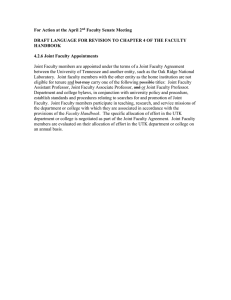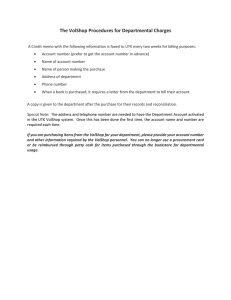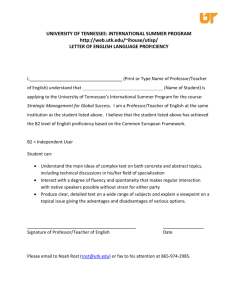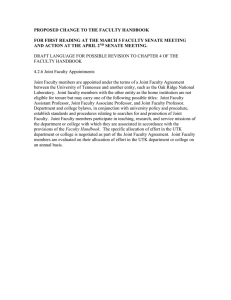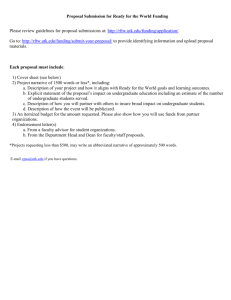1 advancing the university of tennessee, knoxville toward top 25
advertisement
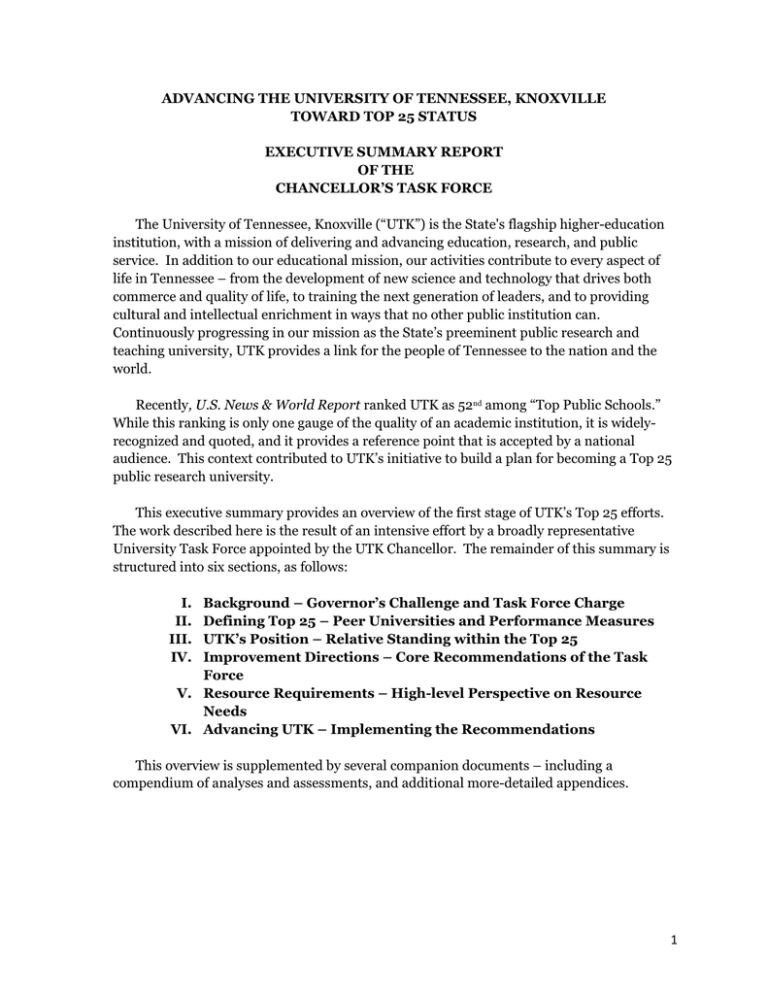
ADVANCING THE UNIVERSITY OF TENNESSEE, KNOXVILLE TOWARD TOP 25 STATUS EXECUTIVE SUMMARY REPORT OF THE CHANCELLOR’S TASK FORCE The University of Tennessee, Knoxville (“UTK”) is the State's flagship higher-education institution, with a mission of delivering and advancing education, research, and public service. In addition to our educational mission, our activities contribute to every aspect of life in Tennessee – from the development of new science and technology that drives both commerce and quality of life, to training the next generation of leaders, and to providing cultural and intellectual enrichment in ways that no other public institution can. Continuously progressing in our mission as the State’s preeminent public research and teaching university, UTK provides a link for the people of Tennessee to the nation and the world. Recently, U.S. News & World Report ranked UTK as 52nd among “Top Public Schools.” While this ranking is only one gauge of the quality of an academic institution, it is widelyrecognized and quoted, and it provides a reference point that is accepted by a national audience. This context contributed to UTK’s initiative to build a plan for becoming a Top 25 public research university. This executive summary provides an overview of the first stage of UTK’s Top 25 efforts. The work described here is the result of an intensive effort by a broadly representative University Task Force appointed by the UTK Chancellor. The remainder of this summary is structured into six sections, as follows: I. II. III. IV. Background – Governor’s Challenge and Task Force Charge Defining Top 25 – Peer Universities and Performance Measures UTK’s Position – Relative Standing within the Top 25 Improvement Directions – Core Recommendations of the Task Force V. Resource Requirements – High-level Perspective on Resource Needs VI. Advancing UTK – Implementing the Recommendations This overview is supplemented by several companion documents – including a compendium of analyses and assessments, and additional more-detailed appendices. 1 I. BACKGROUND Governor’s Challenge and Task Force Charge Rising to Top 25: Building on the Foundation of an Already Great University Governor’s Challenge – UTK and the Top 25 Task Force have accepted a grand challenge from Governor Bredesen: Become a top 25 public research university. Inherent in this challenge is an acknowledgement that UTK is a premier public research university in the State of Tennessee and stands with the nation’s top such universities in key areas of teaching, research, and engagement. The goal of the Top 25 Task Force reflects the imperative to elevate our aspirations, to realize the great potential of our University, and to dramatically strengthen our performance across the board –including promoting the economic development of the State and maintaining our focus on public service. Taking this path is of utmost importance if UTK is to advance our mission of developing the future leaders of our State, expanding human knowledge, and better serving our State, the nation, and the world. Task Force Charge – The Top 25 Task Force was charged to help meet this challenge by performing careful analyses that compare UTK to selected peer universities, understanding improvement opportunities, developing recommendations on strategies for strengthening the University, and outlining possible directions for near- and long-term actions and commitments needed to set UTK on an aggressive improvement path. The Task Force recognizes that UTK prides itself on adding value to the State of Tennessee in multiple ways: by preparing its students to thrive in a global economy, through the creation of new research and creative work that improves the quality of life in Tennessee and beyond, and in reaching out to share our expertise with Tennesseans. This mission is reflected in a set of guiding principles defined by the Task Force: x x x x Improve UTK primarily to increase the quality and value of the education the University provides to its undergraduate and graduate students Build on and further develop UTK’s existing strengths in academics and research, leveraging unique attributes to elevate the University’s status and reputation Affirm a long-term commitment to greatly strengthening the UTK campus for the benefit of all the citizens of the State of Tennessee Demonstrate to the University community and to external stakeholders (including alumni, legislators, and State citizens) the scope of the needed improvements to reach Top 25 status, as well as the time and resources required Concurrent Initiatives - The Top 25 charge clearly reinforces ongoing University commitments to improve and advance. Our priorities, as outlined in this summary, reflect 2 many of those identified in the 2009 Chancellor’s Report, beginning with improving the educational experience and extending to the expansion of research and scholarship. An important current initiative, the Vol Vision academic strategic-planning activity, has and will continue to engage the University community in a rich dialogue regarding our future. Since the Task Force has collaborated with the committee overseeing this effort, our work products and priorities are complementary. We believe our efforts will provide important input that will inform the Vol Vision process going forward. Also vital for advancement is the ongoing, System-wide Efficiency and Effectiveness Study. Our discussions with related campus stakeholders underscore the importance of the view that focusing on improved efficiency and effectiveness will help us to become increasingly better stewards of our resources. The resulting cost savings and process improvements will help liberate resources that can be applied to strategic opportunities. II. DEFINING TOP 25 Peer Universities and Performance Measures UTK’s Vision is Clear: To Realize Our Potential as a Leading Public Research University Approach for defining peers. The Task Force deliberated carefully and extensively to define the list of universities against which UTK should compare itself and its performance over time. Through our work, we honed an initial list of more than 50 institutions to a set of 27 peer and peer-aspirational universities. These 27 schools both highlight the size of the challenge and provide the context needed to tackle it. Our comparison institutions fall naturally into three broad groups (full-listing for each can be found in Appendix I): x x x Aspiration Group: These schools are ranked in the Top 20 of U.S. News & World Report’s “Top Public Schools” and include, for example, the University of California-Berkeley, the University of North Carolina at Chapel Hill, the University of Wisconsin-Madison, and the University of Florida. Top 25 Target Group: These schools are ranked between #21 and #30 of U.S. News & World Report’s “Top Public Schools” and include the University of Minnesota, Clemson University, and Michigan State University. Current Peer Group: These schools reflect similar institutional characteristics as UTK but are ranked higher. This group includes Auburn University, Iowa State University, and North Carolina State University. These peer groups are representative of the broader higher-education universe of leading institutions. Although we have focused on these 27 in particular, analysis demonstrates that a similar picture of UTK’s current position emerges regardless of which subset of 50 or more schools is included in the groupings. 3 Case Studies and Strategic Areas of Focus - To illustrate what can be achieved through focused effort and attention to key performance measures, the Task Force also profiled selected peers that have made major improvements in strategic areas during this decade. More specifically, two schools have advanced to top 25 U.S. News & World Report “Top Public Schools” ranking within the past five years – Clemson University and the University of Minnesota. The rapid advancement of these two schools exhibits several attributes that their improvement efforts have in common: x x x x Sustained commitment to improvement, with long-term goals Progress tracked along measurable performance dimensions Regular communication to stakeholders of progress made and benefits achieved Diverse sources of funds and investment in academic infrastructure, including information infrastructure and support programs for students Similarly, significant and sustained improvement at UTK will depend on establishing measurable goals in strategic areas. To help frame the required strategies, the Task Force identified three interrelated strategic areas of focus that, when integrated into a comprehensive plan, will clearly provide the opportunity for UTK to advance as a leading public research university. Since these areas represent the principal mission elements of the University, they are major themes around which the Task Force has built its recommendations. The three areas are: I. II. III. Undergraduate Education Graduate Education Research Significant and sustained improvement will also depend on overarching inputs needed to support Top 25 strategies. Strategies within each of these broad input categories will need to be closely evaluated to understand the optimal mix needed for advancement. These inputs include: x x Investments, including infrastructure and faculty Increasing our continuing resource base, for example through improved efficiency and effectiveness, tuition adjustments, greater research funding, aggressive private fundraising, and making the case for investment by the State Performance measures - Performance measures must be defined so that progress can be tracked over time. Clear and quantitative metrics are needed to characterize UTK’s position among the peers selected. Beginning with a set of more than 50 possible metrics, the Task Force selected 12 that are both fundamental and reliable indicators of UTK’s progress (Appendix II). The final 12 represent a clean set of independent (but sometimes 4 interrelated) measures that demonstrate important gaps within the three areas of focus and two input categories. For example, the percentage of UTK’s first-year students who return for their second year was flagged as a reflection of the undergraduate student experience. In addition, this figure also relates to improving the six-year graduation rate. As another example, the number of Ph.D. students is an important metric. Ph.D. students are critical to the creation of new knowledge, provide important instructional capacity, and provide role models for undergraduates. Over time, they also add to the University’s prestige, since many will take up academic positions at other leading institutions as well as leadership positions in the government and private sectors. III. UTK’S POSITION Relative Standing within the Top 25 UTK Must Clearly Understand Its Current Position Summary of approach and conclusions – To establish UTK’s current position and therefore establish the basis for improvement, the Task Force worked within the context of the three peer groupings and 12 metrics identified above. Some selected comparisons are included in Appendix III of this Executive Summary. Our data-driven comparison analysis brought us to a set of related conclusions. These conclusions are selectively illustrated below. UTK’s ACT equivalent performance indicates that student quality has recently increased, and we currently stand with many schools in the “Top 25 Target” grouping on this measure. Simply put, we are attracting superior students, just as well as many of the Top 25 schools. While a rise in student quality often supports improved retention and graduation rates, it also makes the imperative to improve those measures all the more critical. UTK is increasingly recruiting the best and brightest, and the success of these students is foundational to supporting Top 25 growth. UTK awards fewer Ph.D. degrees than all but two schools across comparison groups. This observation is particularly significant when one examines the overall mix of degree offerings. While UTK’s peers have grown doctoral degree offerings as a percentage of all graduate degree offerings, including master’s and professional, doctoral degrees remain the lowest such percentage for UTK. While it is important to have an appropriate array of degree offerings, this is clearly one area where UTK lags in comparison with peer institutions. With respect to the measure of endowment per student, UTK is near the lower third of comparison groups. This is a key indicator both of our ability to invest strategic resources to provide a high-quality student experience, as well as of our ability to operate effectively in an environment of decreasing State funding. The Task Force notes that capital campaigns have 5 been a major focus of peers that operate in similar environments, and have at the same time made major improvements. Other conclusions resulting from our data-driven analyses are summarized here: x x x x x x x x The quality of our incoming students is competitive with many Top 25 schools Our biggest challenge in undergraduate education is in retention and graduation We award significantly fewer doctoral degrees than schools in the Top 25 The production of professional and terminal master’s degrees is also low Research expenditures are lower than the Top 25 comparative group; however, recent performance in research awards has shown a marked improvement The salaries of our tenure-line faculty significantly lag relative to the comparison groups, a situation that continues to degrade because of the lack of salary increases We have significantly fewer faculty awards and faculty who are members of the National Academies than our Top 25 counterparts Our total financial resources per student are significantly lower than schools in the Top 25 A word is in order regarding the important metric of the size of the faculty. As indicated in Appendix III, the ratio of undergraduate students to tenure-line faculty shows that UTK is above the average of the Top 25 Group. Thus, this is an area for improvement rather than a source of distinctiveness for UTK. Even while confirming this conclusion, the Task Force wishes to emphasize that more extensive analysis of this measure is required. More specifically, there are questions regarding data definitions and integrity that make such comparisons challenging, both internally and externally. In addition, since faculty deployment is discipline-specific, investigation at the discipline level will be important in further understanding today’s situation and characterizing improvement opportunities. The Task Force believes it important to clarify the rationale for focusing on undergraduate students – rather than total or graduate students – when reviewing this metric. The ratio of undergraduate students to tenure-line faculty is a measure primarily relating to the University’s educating and graduating the next-generation workforce, which has broad implications including the potential for economic development in the State. In general, a university strives to make the undergraduate student-to-faculty ratio as small as practicable. By contrast, the graduate student-to-faculty ratio is in part a measure of a university’s capacity for research activities, and a larger number is better because it enables greater research scale and the production of more Ph.D.s. Since the objectives for these two measures do not align, the Task Force chose to emphasize the undergraduate student-tofaculty ratio because it directly affects the quality of undergraduate education and the undergraduate student experience overall. We note that there are other measures within our 12 executive-level metrics that track graduate education and research success, including doctoral and master’s degrees awarded and federal research expenditures. 6 IV. IMPROVEMENT DIRECTIONS Core Recommendations of the Task Force UTK Should Pursue Broad Improvement in Several Interconnected Areas Improvement Directions - The Task Force was charged to make clear recommendations to the Chancellor on the path to becoming a Top 25 public research university. The recommendations described in this section include broad improvement directions as well as associated strategies and near-term actions. Taken together, our recommendations reflect our view that UTK’s Top 25 strategy should be comprehensive and serve to integrate the major activity areas of undergraduate education, graduate education, and research. More specifically, the Task Force developed several principles that provide the foundation for our recommendations: x x x x x UTK should capitalize on our current strengths and strive to make concurrent progress in several areas (undergraduate education, graduate education, and research), rather than adopt a singular focus Holistic strategies should be developed that will lead to performance improvements in important high-level progress measures Related investments should be driven by strategic direction and should be synergistic (for example, investments in infrastructure, support, faculty, and scholarly information resources should contribute simultaneously to undergraduate education, graduate education, and research goals) Action plans should incorporate both near- and long-term views, recognizing that a sustained, committed effort will be required for progress The Task Force’s analysis must represent the beginning of an ongoing conversation; UTK should proceed with regular communication among key internal and external stakeholder groups Suggested Strategies and Near-Term Actions - The Task Force has identified several strategies that would clearly advance UTK in the indicated directions of improvement. These align with the three areas of focus and also support a broad view of campus-wide improvement. The following list represents a selection of recommended strategies: Improving Undergraduate Education x x Dramatically improve the overall undergraduate experience (academics and student life), which will result in a significant increase in retention and graduation rates Meet the challenge of having high-quality students through expanding such initiatives as learning communities, research experiences, and honors programs 7 x Increase the opportunities for undergraduate students to interact with tenureline faculty in the classroom and in research and creative activities Expanding Graduate Study x x x Dramatically increase the number of Ph.D. degrees granted Attract a greater pool of the best graduate students by making graduate stipend packages more competitive Evaluate opportunities to expand, leverage, and integrate graduate professional degree programs (including, for example, those in the College of Law, College of Business Administration, Baker Center for Public Policy, College of Social Work, School of Information Sciences, and College of Veterinary Medicine) Growing Research x x x Invest in strategic faculty hires (for example, Governor’s Chairs, National Academy Members in Science and Engineering) Adopt a long-term focus on growth in federal research funding which supports the application of new knowledge to advance economic development in the State Leverage natural strengths and current advantages (for example, proximity to Oak Ridge National Lab and the relationship with the University of Tennessee Health Science Center) Investments x x x Advance physical and information infrastructure modernization and improvement efforts Investigate the impact of faculty and staff salary on retention, and address gaps accordingly Pursue faculty, infrastructure, and support growth as driven by undergraduate, graduate, and research strategies Resources x x x x Continue to execute efficiency and effectiveness efforts to liberate funds for academic purposes Evaluate opportunities to align UTK fundraising initiatives with Top 25 action plans Review tuition gaps between UTK and peers Develop business cases for commitments by the State that will help UTK better serve the interests of Tennessee The Task Force has developed a list of suggested actions to support these strategies. Some of these actions can begin immediately, with little or no additional resource commitment, while others require a more long-term view and significant new investment. 8 A selection of such actions includes: x Identify specific, prioritized investments that will lead to closing the graduation and retention gap x Evaluate the graduate stipend issue more fully and develop an appropriate adjustment plan x Develop a growth plan for graduate education with required investments (faculty, infrastructure, stipends, etc.) x Complete further study on opportunities to increase the number of post-doctoral fellows x Link graduate education growth strategies with increased research capacity and economic development for the State x Undertake a detailed analysis of the size of our faculty relative to those in the Top 25 comparison group with respect to providing the improvement and growth opportunities in undergraduate education, graduate education, and research x Complete further evaluations of faculty and staff salary gaps, review the impact on retention, and develop a salary adjustment plan with the objective of attracting and retaining stellar faculty and staff x Develop a Top 25 infrastructure plan to address modernization and growth plans x Integrate action plans into a multi-year, Top 25 financial plan that logically sequences investments based on a realistic view of source of funds and is accountable While careful thought will need to be given to the implementation and sequencing of these strategies and actions, this planning must begin now if UTK is to be best positioned to move forward. V. RESOURCE REQUIREMENTS High-Level Perspective on Resource Needs Progress Requires Sustained Resource Commitments The experience of others demonstrates that becoming a Top 25 public research university is a formidable, multi-year, resource-intensive challenge. Universities that have 9 made significant progress have sustained high-intensity improvement efforts over many years with corresponding financial investments. For example, Clemson and Minnesota supported programs for achieving strategic goals in part through increases in available funds. Each undertook a large-scale capital campaign, raising $295 million and $1.6 billion, respectively. Each expanded annual giving from alumni and friends. Both realized substantial cost savings through process improvements and efficiency efforts renewed in successive initiatives. Minnesota also worked to increase its research funding from outside sources, while Clemson increased tuition by an unprecedented amount. Beyond financial commitments, success also depends significantly on continuing investments of time, attention, and energy on the part of the University. While long-term programs such as these are properly executed in phases, a sense of urgency and commitment is an essential factor in realizing sought-after goals. In this initial effort, the Task Force was not charged with quantitatively projecting resource requirements. Based on the experience of others, UTK is certainly embarking on a decade-long endeavor that is unprecedented in its history. But the Task Force wishes to stress that many of the early action steps can be taken promptly and with a relatively small investment of new resources. For example, making progress on retention rates involves such steps as strengthening our approach to advising incoming and first-year students. Finally, we note that while the mix of funding sources to support a progression towards Top 25 depends on many factors, the experience of other universities suggests that key elements are continuing efficiency and effectiveness improvements, expanded research funding, increased tuition revenue, and capital and annual fund-raising. VI. ADVANCING UTK Implementing the Recommendations Near-Term Steps Initiate the Transition from Analysis to Action The first steps in implementing the Task Force’s recommendations will initiate the transition from the analytic work of the Task Force to the planning and actions needed to begin to accelerate progress. These steps include: x With the support of the Task Force, the Chancellor needs to clearly communicate “Top 25” objectives and initial, related findings to all stakeholders – including the University community, Board of Trustees, legislators, and citizens of the State. We recognize that the all-encompassing scope of this Top 25 charge requires broad-based understanding and support as an essential element for success. x To maintain momentum, it is necessary to establish implementation working groups. Group membership should be designed to ensure perspectives and points of view from across the University, including significant participants in all 10 three major themes—undergraduate education, graduate education, and research. These working groups need to be tasked initially with completing additional fact-gathering and analysis. x These implementation working groups will ultimately need to develop action plans for each area of focus. Such plans will build on the initial action steps recommended by this Task Force, and they should eventually be integrated into a coordinated and logically-sequenced effort. x Action plans developed by the implementation working groups will necessarily require identification of related resources. These resources will take many forms, from time and project management, to increased efficiency and effectiveness, to new and additional funding. The commitment of such resources needs to be prioritized according to the logical sequencing of the action plan. x Keys to T0p 25 advancement are a spirit of accountability and a long-term view. UTK will need to establish a supporting framework for accountability, including a process and timeline for progress reporting that allow for clear tracking of related efforts and benefits to stakeholders. x UTK has already undertaken efforts that align with broad advancement of the University, including Vol Vision and the System-wide Efficiency and Effectiveness Study. Proceeding most effectively requires continuous coordination among these complementary efforts. The Task Force embraces the Governor’s challenge and appreciates the opportunity to serve the Chancellor in seizing the initiative to transform UTK. What is required now is a sense of urgency. We understand where we want to go, what path we must take to get there, and what the benefits will be for our students and for the State of Tennessee. We look forward to the next steps in this extraordinary and invigorating journey. 11 Top 25 Task Force Members Bruce Bursten (Chair) Susan Benner Doug Blaze Toby Boulet Bill Brown Chris Cimino Donald Cunningham Barbara Dewey Brad Fenwick Judy Moore Ted Stank Carol Tenopir Drew Webb 12 Appendix I - Benchmark Schools Rank1 Schools by Grouping 1 2 2 4 5 9 9 11 11 11 11 15 15 18 18 20 Top 20 US News Rank University of California – Berkeley University of California – Los Angeles University of Virginia University of Michigan – Ann Arbor University of North Carolina – Chapel Hill University of Illinois – Urbana-Champaign University of Wisconsin – Madison University of California – Davis University of California –Santa Barbara University of Washington – Seattle Pennsylvania State University University of Florida University of Texas – Austin The Ohio State Universityy University of Maryland – College Park University of Pittsburgh 21 22 22 22 22 26 29 29 #21 – #30 US News Rank University of Georgia Clemson University u due U University e s ty Purdue Texas A&M – College Station University of Minnesota Rutgers, The State University of New Jersey Indiana University Michigan State University Top 25 Target Group 39 39 39 #31 – #39 US News Rank Auburn University Iowa State University North Carolina State University – Raleigh Current Peer Group Source: U.S. News & World Report “Top Public Schools, ” 2010 Aspiration Group 13 Appendix II - Performance Measures Areas of Focus Metrics ACT Equivalent (75th/25th Percentile) Undergraduate Education Retention Rate (1st to 2nd Year) Six-Year Graduation Rate Number of Ph.D. Degrees Graduate Education Number of Master’s/Professional Degrees F d lR Federal Research hE Expenditures dit Research Total Research Expenditures Avg. Tenure-Line Salary Range Faculty Undergraduate Student/Tenure-Line Faculty Faculty Awards T Teaching hi and dS Supportt E Expenditures/ dit / St Student d t Financial Resources and Infrastructure Endowment/ Student 14 Appendix III - Current Position Relative Standing Compared to the Top 25 UTK Top 25 Target Group UTK vs. Top 25 Target Group ACT Equivalent (75th/25th Percentile) 29/24 28.5/23.5 +.5/.5 Retention Rate (1st to 2nd Year) 84% 90% -6 pts Six-Year Graduation Rate 60% 75% -15 pts Number of Ph.D. Degrees 277 486 -209 Number of Master’s and Professional Degrees 1,845 2,130 -285 Federal Research Expenditures $70 M $182 M -$112 $112 M Total Research Expenditures $165 M $427 M -$262 M $67 to $108 K $73 to $120 K -$6 to $12 K Undergraduate Student/Tenure-Line Faculty 20 19 +1 Faculty Awards 10 32 -22 Teaching and Support Expenditures/ Student $16,100 $24,300 -$8,200 Endowment/ Student $14,380 $38,400 -$24,020 Areas of Focus Undergraduate Education Metrics Graduate Education Research Avg. Tenure-Line Salary Range Faculty Financial Resources and Infrastructure Sources: UTK institutional data; Institutional Common Data Sets; U.S. News & World Report; The National Science Foundation; The Center for Measuring University Performance; Institutional Annual Financial Reports; Council for Aid to Education 15 Appendix III - Current Position ACT Equivalent by Rank (Representative Example) UTK’s ACT equivalent performance is comparable to many schools in the Top 25. AC CT Equivalent Range - 75th and 25th h Percentiles 2008 34 32 30 29/24 28 26 24 22 20 University, by 2010 U.S. News Rank Source: U.S. News & World Report Note: SAT scores reported are converted to the ACT equivalent using College Board ACT-SAT concordance tables 16 Appendix III - Current Position Six Year Graduation Rates (Representative Example) Six-Year UTK lags behind all schools reviewed in six-year graduation rates. 95% 95% Virginia Berkeley UNC 90% UCLA Michigan 85% 6-Year Grraduation Rate (% %) 2008 – Trackking Fall 2002 Coh hort Penn State Clemson Texas A&M UMD Georgia Wisconsin Illinois Florida UC Davis & Santa Barbara 80% UT Austin Washington Pitt Michigan State 75% Rutgers Indiana Purdue Ohio State 70% NC State Iowa State Minnesota 65% Auburn Rank #52, 60% 60% 55% 50% 50% 0% 60 50 40 30 20 10 0 2010 U.S. News Rank Sources: UTK institutional data; Institutional Common Data Sets; U.S. News & World Report 17 Appendix III - Current Position Number of Ph Ph.D.s D s Awarded (Representative Example) UTK awards fewer Ph.D.s than all but two schools across comparison groups. 1000 900 Number o of Ph.D.s Awarded 2008 – 2009 800 700 600 500 400 277 300 200 100 0 University Sources: UTK institutional data; Institutional Common Data Sets 18
